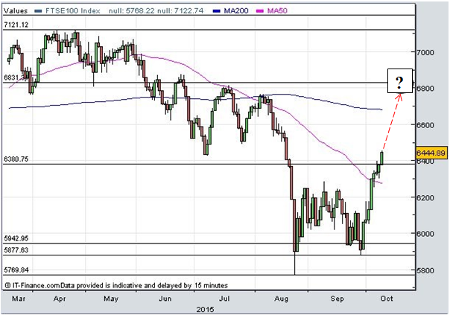FTSE 100 up 10%, and tipped to keep going
9th October 2015 13:33
by Lee Wild from interactive investor
Share on
With interest rates hikes off the agenda and growing speculation that another round of quantitative easing may be in the offing - QE4! - stockmarkets are blazing higher Friday. Incredibly, the has now risen 10% since hitting a two-and-a-half-year low last week, and the tea leaves are pointing to further potential upside.
At 5,877, the blue chip index looked dead in the water - it hadn't been that low since late 2012. But just before lunch on Friday it made a best of 6,453, up 79 points. You have to go all the way back to mid-August to see the last print that high.
On Wednesday, we asked our technical analyst friends at Trends and Targets what the charts were saying. Alistair Strang had previously told us that a break above 6,417 could lay the foundations for another major surge to 6,750. It has, but the omens now are even better.
"The big picture calculation is now 6813 as the ruling attract," he says. "Hopefully world events over the weekend don't do anything to spoil the potentials."

A substantial portion of the FTSE 100 rally has been driven by the mining sector, and Friday is no exception. Right now is up over 11% at 134p - it was less than 67p last week - and some think there's more to come. Given the massive debts carried by the miner, though, this is a true high-risk trade.
, , , and are all up as much as 8%, despite a UBS downgrade to commodity price forecasts. The broker admits that a "cyclical rally over the next 3-6 months in base metals" is possible. Emerging markets-focused bank has gatecrashed the party, and is in demand amid heavy director share buying.
While demand for equities in what is traditionally a great quarter for them is encouraging, economic data continues to disappoint, and the International Monetary Fund (IMF) has just downgraded its forecast for global economic growth this year to 3.1% from 3.3%. So why the frantic share-buying?
"Just as when markets lurch down as traders are stopped out or hit by margin calls, so they spike up when the opposite happens," explains Mark Tinker, head of AXA Framlington Asia. "In the case of equities there have undoubtedly been some quite vicious short squeezes."
"If history is a guide, the noise markets will likely soon change the narrative - conflict in the Middle East and still healthy growth in China will be presented as reasons to buy back the oversold positions in commodities and emerging markets (EM)."
And the EM team at Barclays have a view, too. "It appears that investors who were sitting on the sidelines have begun to put money to work at the start of Q4." Higher commodity prices and less negative comments by Moody's about Brazil have been taken well, but the broker sees little fundamental justification for the sharp rebound in EM assets.
Instead, it agrees with Tinker, believing that technical factors - squaring off short positions and fund managers putting cash to work to try and improve fund performance - have driven markets. "If this is the case, this raises serious doubts about the sustainability of this rebound."
This article is for information and discussion purposes only and does not form a recommendation to invest or otherwise. The value of an investment may fall. The investments referred to in this article may not be suitable for all investors, and if in doubt, an investor should seek advice from a qualified investment adviser.